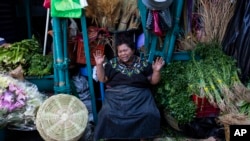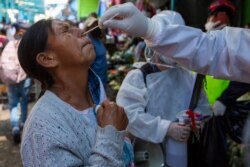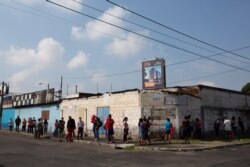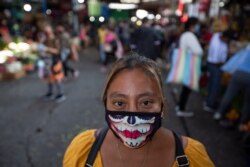For years, Cruz Pelico made a living by tending to onions, carrots and lettuce in the rolling fields outside his small Guatemalan town. But even with the long, labor-intensive hours, the 25-year-old farmer struggled to support his wife and 5-year-old son.
So in 2019 he began planning to migrate to the United States to lift his family out of poverty.
But as coronavirus tears through the U.S. and lockdowns cut off migrant pathways, Pelico dropped his plans to migrate.
“I'm not thinking about going anymore. With this situation, you can't get there now,” Pelico said. “The United States has fallen into crisis, too. Many Guatemalans who are there have told me,” he said. “There's no work anymore. I've started thinking it's better to be here.”
Instead of embarking on their journeys northward as people in his town, Zuníl, had done for decades, Pelico said recently departed Guatemalans were returning out of fear. It is unprecedented for a town whose economy was sculpted by generations of migration.
Deterred
Zuníl’s situation is not unique. Migration northward is dropping off across the region as rising obstacles — fear of contagion, lack of work in the U.S., mobility restrictions and the Trump administration’s restrictions on migration during the pandemic — have made the journey all but impossible.
“They never made it,” Pelico said. “They are returning because they were scared of this pandemic we’re suffering, because of everything happening in the United States.”
That could be disastrous for tens of thousands of Central American and Mexican migrants who have fled not just poverty but also an onslaught of violence in recent years.
From March to April, when the U.S. began to lock down, total apprehensions along its southern border dropped by 50%, according to U.S. Customs and Border Protection data.
Apprehensions and expulsions have plummeted, going from 109,415 in April 2019 to just 16,789 in April 2020. At the same time, Trump administration officials announced they would indefinitely extend border restrictions made during the pandemic.
The order from Robert Redfield, Centers for Disease Control and Prevention director, allows the administration to rapidly expel asylum-seekers and immigrants, including unaccompanied minors, crossing the border.
The administration began a limited implementation of the policy in March, citing fears that the migrants may bring the virus to the U.S. Redfield extended that order on May 21, saying it would remain in place until “further introduction of COVID-19 into the United States is no longer a serious danger to public health.”
The border continues to be closed to workers deemed nonessential, and the processing of asylum claims has all but stopped.
Criticism
Critics like Jessica Bolter, an analyst at the Migration Policy Institute (MPI), said that with the latest measures, the Trump administration was “taking advantage” of the health crisis to end asylum.
The clampdown comes after months of the U.S. government implementing policies that make it harder to legally migrate or seek asylum. Among those policies are Trump’s “safe third country” agreements, which has sent asylum seekers to Guatemala, and soon, Honduras and El Salvador, nations that's violence that has pushed many to flee in recent years.
As a result, rates of migration were already dropping.
Meanwhile, quarantines and border closures have cut access to frequented migrant routes through Central America and Mexico.
“There's much more risk involved in trying to migrate north right now,” Bolter said. “If there aren't any jobs in the U.S., either, there's a question of if migration to the U.S. would even be seen as worth it.”
Along the U.S.-Mexico border, migrant shelters and kitchens that still remain open report similar dropoffs.
Only the “most vulnerable” stay, said Katie Sharar, a leader at the Nogales, Mexico-based migrant kitchen, Kino Border Initiative.
“Those that largely remain are those who cannot go home,” Sharar said. “They will not survive if they go home.”
Limbo
Kino’s soup kitchen once bustled with recent deportees, and volunteers offered medical, psychological and legal help to migrants. In 2019, more asylum-seekers began arriving at its doorstep, a product of the Trump administration’s “Remain in Mexico” policy, which requires those seeking asylum to wait in Mexico for their cases to be heard.
Gonzalo, a Venezuelan asylum-seeker whose surname is being withheld for his safety, had been waiting since June 2019 in Nogales on the Mexican side of the border, just opposite the U.S. state of Arizona.
Gonzalo fled Venezuela after he was kidnapped and faced death threats, and is among 5 million people who have fled the crisis-stricken country in recent years. He said the terror he felt in Venezuela, he also feels in Mexico as illegal armed groups sow violence and target and kidnap migrants like him.
“There are urban terrorist groups, there's a lot of narco-trafficking. We’re very scared to be here for so much time because we're easy targets for these groups,” he said.
Now, with the U.S.’s indefinite migration restrictions, Gonzalo said he has nowhere to go, and fears exposure to the virus as he washes cars on the streets and struggles to find small handyman jobs to survive.
The shelter he and many other migrants once stayed at has closed its doors, and other organizations like Kino say that they have had to reduce services to protect staff and the migrants they serve from infection.
Returning to Venezuela is not an option, but waiting on the border might kill him all the same.
“The hardest thing is waiting with this virus, to be so exposed.” he said. “We're living with the same fear for our lives.”
A small handful of asylum-seekers who have been let through in recent weeks allow him to hold on to hope and continue his yearlong limbo.
Bolter, the MPI analyst, said it’s likely that the Trump administration will continue these heightened migratory measures even after the pandemic ends in order to continue deterring migration to the U.S.
At the same time, Pelico in Guatemala, also feels stuck. He worries that staying may mean starvation for his family as a government quarantine makes it impossible for him to work more than a few hours a day or sell his crops in markets. Before, he earned less than $10 a day.
“I'm just a farmer. Day to day, we live off what we grow,” he said. “My fear, my worry, is if they close us in for a month, two months, what are we going to eat?”
But Pelico knows the risks of going north: He made the journey through Mexico and perilous border desert terrain in 2013. He worked in Oklahoma and returned home less than a year later because his mother was sick. With the pandemic, though, he said the risks are too great.
Guatemala is where he will stay for now, but Pelico said that as time ticks on, his mind might again wander northward.
“I hope that God will give us a future that will let me go in the next year, but not until what we're going through calms down,” he said. “Then, I'd think once again about if I stay or if I go.”










